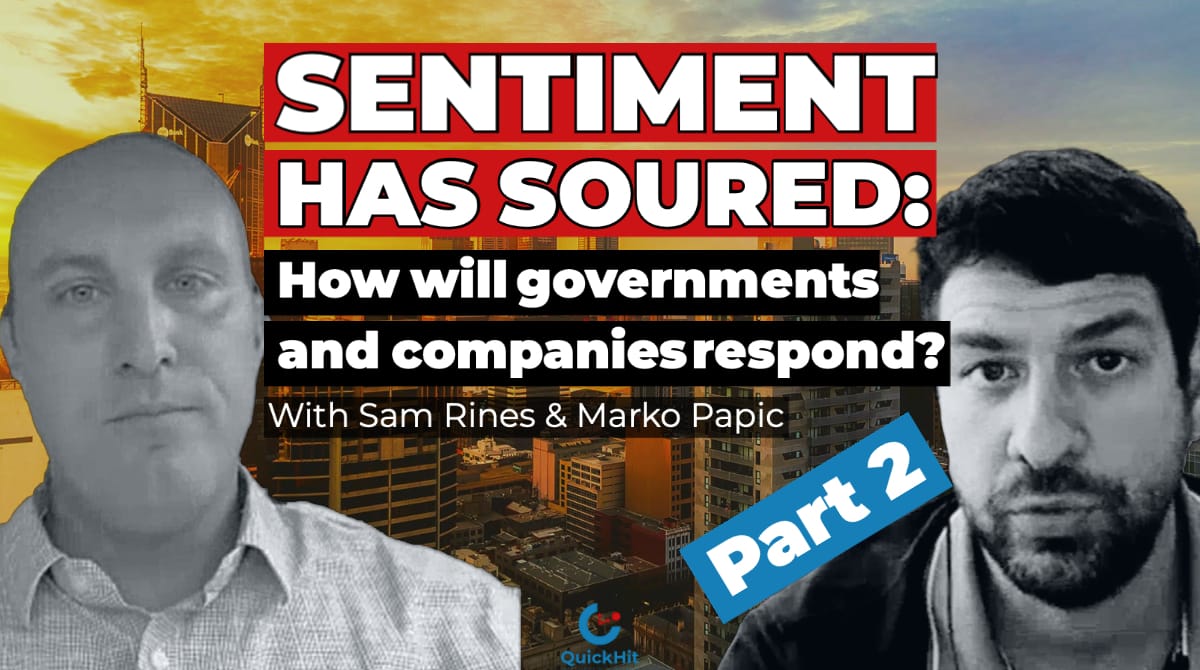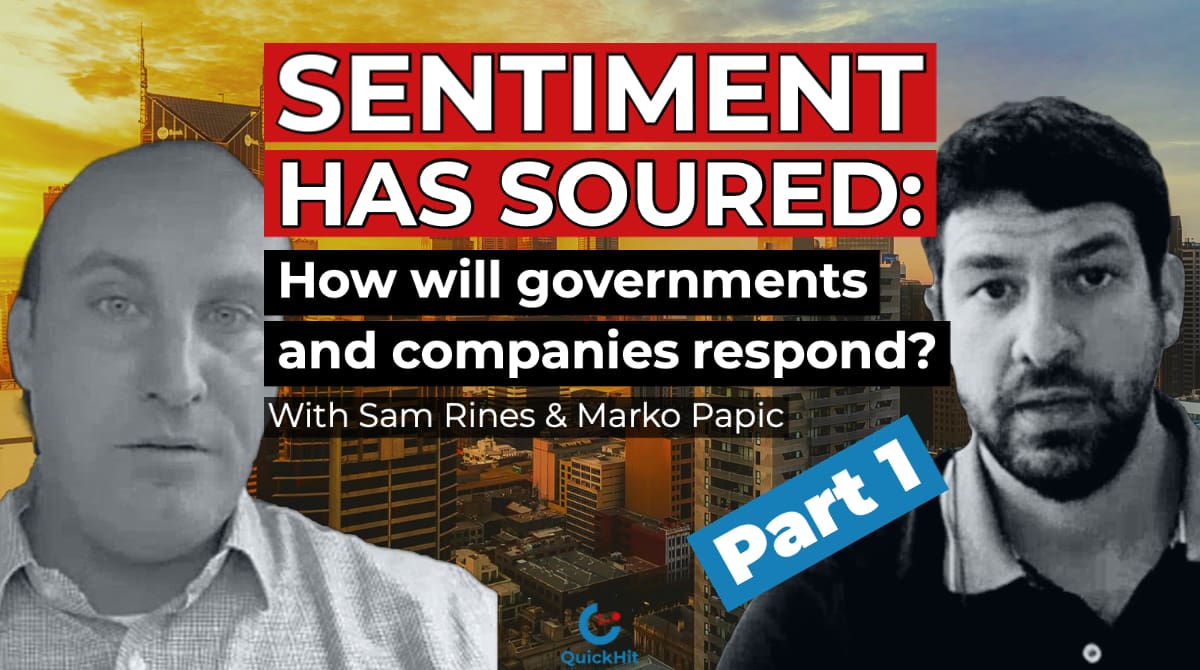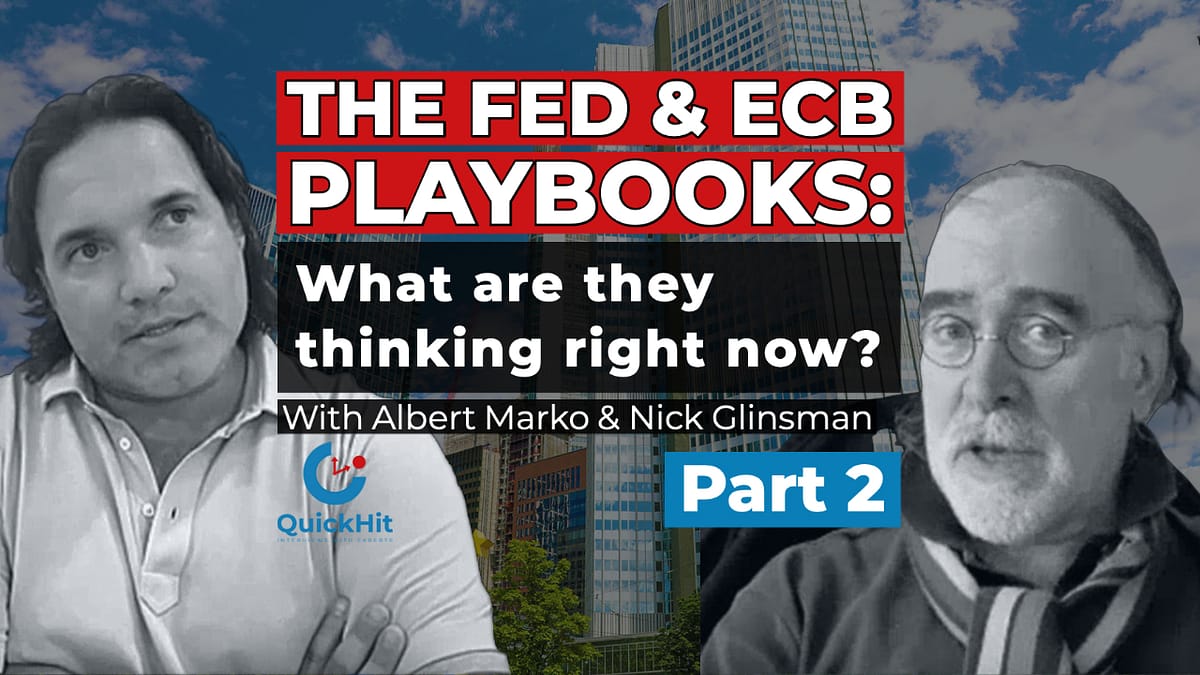In this second part, Sam and Marko discussed possible tapering, what can the government do to help private companies, how the consumer sentiment is looking right now, what should you do with your investment in this Delta variant scare? Are vaccines really effective? And what is this thing that the Biden administration needs to do right or they’ll be dead?
Please go here for the first part.
Subscribe to our Youtube Channel.
💌 Subscribe to CI Newsletter and gain AI-driven intelligence.
📊 Forward-looking companies become more profitable with Complete Intelligence. The only fully automated and globally integrated AI platform for smarter cost and revenue planning. Book a demo here.
📈 Check out the CI Futures platform to forecast currencies, commodities, and equity indices
This QuickHit episode was recorded on August 19, 2021.
The views and opinions expressed in this Sentiment has soured: How will governments and companies respond? (Part 1) QuickHit episode are those of the guest and do not necessarily reflect the official policy or position of Complete Intelligence. Any contents provided by our guest are of their opinion and are not intended to malign any political party, religion, ethnic group, club, organization, company, individual or anyone or anything.
Show Notes
TN: Sounds like both of you agree that China is going to do more stimulus. I think they’re late. I think they should have started five or six months ago. But better now than never. Right. So it sounds to me like you believe that there will be the beginning of a taper, maybe a small beginning of a taper late this year. Is that fair to say?
SR: Yeah, I think it’s fair to say that there will be some form of taper. Okay. I don’t know, even if it’s just rhetoric, as we move into 2022, at least with what we know right now, I don’t think they should. But what I think they should do and what they’re likely to do are two wildly different things.
TN: So even if it say 10 billion a month, which is nothing compared to the entire kind of stimulus, monetary stimulus are doing right now, that would have a dramatic sentimental chain. Is that your view?
SR: Yes. So it’s all about that incremental change in Cinnamon. It’s not about the incremental change in the addition to the portfolio.
TN: Right. Marko, are you the same? Do you think there’s a change in the sentiment of the Fed and there’s going to be a move toward tapering late in the year?
MP: I mean, I think tapering happened in June at the FRC meeting. And so that’s… Because that’s when the Fed incrementally turned hawkish. The DXY dropped quite significantly after the meeting. So I think that the risk in your view is that a lot of the things that we’re talking about right now have been slowly priced in over a period of time. And while oil prices and S&P 500 haven’t really corrected to this view reality. You know, so S&P 500 is reaching a new high, except for the last two days. Oil prices have started to come down finally.

Now the 10-year has actually been pretty stable through the last couple of weeks worth of volatility. And that tells me a couple of things. I think the bottom market price, a lot of the things we’re talking about already. The second issue is that fiscal policy is really tricky when we talk about it.

And here’s what I mean. 1953 we had a fiscal cliff recession after the Korean War. But that’s because the fiscal cliff was very clean, very simple. We spend a lot of money on bullet casings and tanks and airplanes during the Korean War, and then that fiscal spend stayed on the Korean Peninsula. We couldn’t take it back with us in 1953. In other words, we got a fiscal cliff recession.
This time around, the 1.9 trillion, you know, fiscal stimulus we had earlier this year, that actually, in a curial mathematical terms, shows up as a huge fiscal cliff next year. But that actually lives on on household balance sheets. And so that’s where I would say that like, let’s see how the Delta variant issue resolves itself, because in one month, here’s what I know.
I know the savings rate in the United States, the personal savings rate is still elevated at 9.6%. I know that revolving credit is going through the roof, and the households are re-leveraging themselves in a way that they have it for ten years. The US consumer is acting in the ways they acted in the 90s and 2000s.
If you look at household debt, percent of GDP, you got this long period of deleveraging for the past ten years. And now it’s coming back up. And so to me, that’s where I think the fiscal cliff of next year is overstated. And the reason that even a ten year fiscal package matters is because you’re talking about a ten-year bond. If I’m going to hold a ten-year bond, that on the back end of that 10-year, there is Trump tax cut level of unnecessary fiscal stimulus.
Let me say that again, what this fiscal spend right now is going to produce a similar procyclical fiscal thrust that we had during the Trump administrations in the last two years, through doc cuts, this time through infrastructure spending. That’s going to create a modest fiscal thrust, positive fiscal thrust for the duration of the asset that you’re holding. And I think that the market will still have to respond to that, even though next year there’s no way to avoid mathematical fiscal flip.
TN: Interesting. So. All of these things together, just going back to the reason I initially contacted you guys. I was hearing companies telling me that their Q3 revenues were really, they were downgrading them, and they’re really worried about their performance in Q3. And I think we’ve seen that or I’ve seen it anecdotally.
We saw tourism not necessarily be what we thought it would be. We’ve seen a lot of things happen that we didn’t really think would happen over the summer or not happen that we thought would happen. So how are you seeing these policies or how do you expect these policies to manifest at the company level? And when do you expect them to help companies to move forward?
MP: Well, I don’t think any policies will help companies. I think what will help companies is once Covid cases go down, and people kind of stop being afraid of the Delta wave.
Right now, if you look at hotel stocks. Hotel stocks are back through, like November 20th level, like they’re back to pre-Pfizer result levels. And I think that that’s a great investment opportunity. I would be long COVID place right now because, you know, the data from Israel, the data from Iceland, the data from a lot of different places that are fully, almost fully vaccinated are pretty clear, which is that vaccinated people can absolutely get Covid, and very few of them have adverse effects. The efficiency is actually at very high levels. A lot of people misinterpret, a lot of people… Sorry, the media is misinterpreting the data. And once you account for age disparities and so on, the efficiency here is like in the 90s.
TN: So it’s amazing.
MP: Yeah. Look, it’s a simple fact. Now that’s going to take some time as Sam said, I think that’s going to be articulating the data for the next month. I think that you have a great entry point into the Covid place right now. And I don’t think that any of the policies we’re really talking about are going to have much of an effect on earnings over the next quarter.
TN: I’ll give you a data point that I was looking at earlier today. Texas right now has the same number of cases that it had in Feb of ’21. Okay. But the daily fatalities are 60% lower than they were in Feb. Okay. So the case counts are just as high, but the fatalities are dramatically lower. And that’s good news, right.
MP: Look, Tony, I would study really the case of Israel, because if you study the overall numbers in Israel, you come up with a figure. I think it’s 60% effectiveness for Pfizer, which is lower than advertising, but that’s actually a mathematical concept called a Sisyphus paradox.
And what’s happening is that we need to segregate the different age cohorts not just average them together.
TN: That’s right.
MP: You know, because the elderly tends to be more vaccinated. You have a larger pool of older people who tend to have received a vaccine. They also tend to go to a hospital more often with a respiratory disease, even though they’re vaccinated.
So you can’t just average everyone together. The actual vaccine efficacy is in the 90s for all cohorts. Except in the 80s for some of the much older, over 80. It’s, like, about 80% effective. And so, yeah, I think a lot of this is… You know where I want to compare Covid to? And I think Sam will appreciate this. I compared it to the Euro area crisis.
You could have made a call in 2010 that this thing was over. Like once Germany like bit the bullet and bailed out Greece the first time? Like it was over, guys. But every time a new country showed up, he was like, Whoa. Here goes Portugal. Oh, my God! The world’s gonna end! And it’s like, similarly COVID, like, we know where we’re headed. Like, every wave is gonna cause sentiment issues and so on. But I would just bet against those.
TN: That’s a good call. I like that. I like the optimism there, and I like the perspective there. I think that’s really interesting. Sam, what do you think?
SR: I think there’s a combination of two things. One, I think Marco is 100%, right? That this is an awful lot like the Euro area crisis. Every single time, like Greece was the first big bang. Then you had the ripple effect to Portugal. Then it was Spain. And everybody was wondering what the next set of fall was and had the correction of 2011. That was fun. You had these longer term kind of ripples.
I think there’s going to continue to be ripples this time around. And the question is in my mind, it’s really difficult to predict what people sentiment around those ripples are going to be. I think we can look through them for the next five to ten years and say it’s all going to be fine. This is the way it’s going to play out.
The real question is, how does the American consumer mindset, how does that actually grasp this ripple to move through it? And how does China react? How does Europe react? Right. There’s a number of factors that play in here, but I think the really difficult and maybe not as priced in as they should be. To Marco’s point. I think this is a really long term, very strange kind of predicament that we’re in where vaccines are really good. They work really, really well.
How do people’s minds begin to grasp it? And do they begin to look through? We get the higher vaccine rates? Do we really power through this in a meaningful way, very, very quickly, or does it continue to be highly volatile on the consumer sentiment front? Because if consumer sentiment continues to fall, it’s going to be a big problem for the back half of this year. And that I mean. It’s kind of…
TN: We’re right there at the back there in the back half of the year, right? That. This is a terrible time for consumer sentiment to fall because we’re at the precipice of kind of holiday season buying. Not quite there yet, but if it stays for two more months, it gets pretty bad.
SR: It does get pretty bad. But I think this is also one of those points that I think could really be a tailwind to Marko’s earlier comments about fiscal stimulus and fiscal stimulus being higher than anticipated. You continue to have consumer sentiment fall. You continue to have people fearful of Delta, you have a couple of bad job prints, and all of a sudden you’re going to have much higher fiscal spend. You’re going to have a very dovish Fed.
TN: Right.
SR: I think that’s the risk to call it “the market.” That’s the risk to kind of my side of Marko and I’s bet is if all of a sudden this fear actually really ingrains itself within individuals, it’s going to be a huge, huge issue as we move into the Christmas buying season for companies, Christmas buying season for consumers, and you’re going to get big checks written out of Washington, regardless of the geopolitical situation, regardless of whether or not people want to say Biden might be lame duck because of Afghanistan, etc.
All of a sudden you’re going to have a Fed that’s very concerned, thinking it was a ripping economy with incredible inflation that wasn’t going anywhere. You’re going to have them reverse very, very quickly. You’re going to have senators on both sides of the aisle very concerned that they just, they might get blamed for a recession.
It’s going to be a really interesting queue for.
TN: It is.
MP: That’s why it’s a dynamic environment. Right. And and what I would say is like, look, I have certainty on the Delta wave. Certainty. Every wave we’ve had has crested, other than in emerging markets because their testing is poor. So it’s actually a mega wave that we constantly think is over, but it isn’t.
In the US we know how the story plays up. We know it. It’s a four to six week wave. The challenge here Tony, is that we’re talking in the middle of this wave. We have probably another two to three weeks of upswing, and then we’re going to have a down swing in cases. And by the way, I know this with a science, like, a hundred percent certainty because we had waves collapse even before we had vaccines.
So this is a really important point, because if the Fed reacts to something that is extremely impermanent, something that’s over in three weeks, if the Fed at Jacksonhole and subsequently in September waivers, you know, I mean, that will just set, I think the market alight, in my view. I think that will collapse the dollar and they will sell the bond, because it will have been using this, you know, temporary blip in sentiments to justify a changing course.
The other thing I would say is, like, so Sam mention Afghanistan. I think he’s right to mention it. I think it’s really significant, and it’s significant because of this. I think… I’ve always expected that during the summer, the fiscal policy would get much more challenging. And now, because of the Republicans, I think moderate Democrats in the Senate versus progressive Democrats in the House were always going to try to eat each other alive.
But now, with this utter failure in Afghanistan, that looks really, really bad, they are going to circle the wagons on fiscal calls because the last remaining, the last remaining lever of the Biden administration is this fiscal package. If they don’t get it through, guys. Yeah. The Biden administration is done. And I mean, I’m not talking about midterms either. So they have to do something on fiscal. Right.
So this is why the stakes have now become much higher. They’re gonna pay Mansion. They’re gonna pay Cinema. They’re gonna get deep water ports in Arizona and West Virginia to get their compliant with a fiscal deal. You know what I mean? Like, there’s gonna be so much more. I wish I was living in West Virginia. I mean, they’re gonna have ice rinks in every little town. It’s gonna be amazing.
And so this is something to keep in mind, I think on that front, too. So I agree with Sam. I think it’s a really good point of how these things are very dynamic and they reinforce each other. And I just think that the political pack of lease resistance in every single issue we’re talking about here leads to more profligacy.
TN: Yeah, I think you’re right. I think at least for the near term, that’s the bias, is exactly in that direction.
Okay. Guys. Thank you so much. Again, I think we could go on for hours with this, and I love this discussion, but I really appreciate your time.
For everyone who’s watching. Please subscribe to our YouTube channel, where we need a few more subscribers to bring you a few more capabilities on our channel. If you don’t mind, please subscribe.
And Sam and Marko. Really appreciate your time. Thanks very much.
MP: Thank you. Thank you.
TN: Let’s do it again, and I want to come back in January and see who wins.
MP: Yeah, sure. We should definitely do that. We didn’t tell people when we been into, but it’s like a really nice steak dinner, I think was the… If the 10-year is at like between one point 49 and one point 51, I think we just…



















